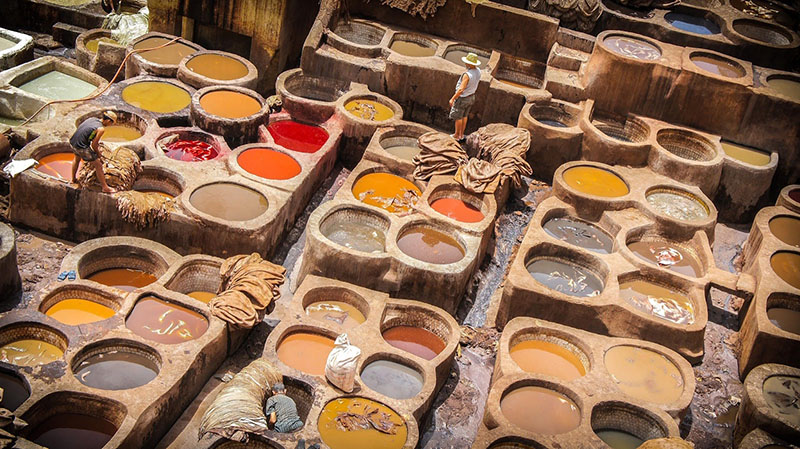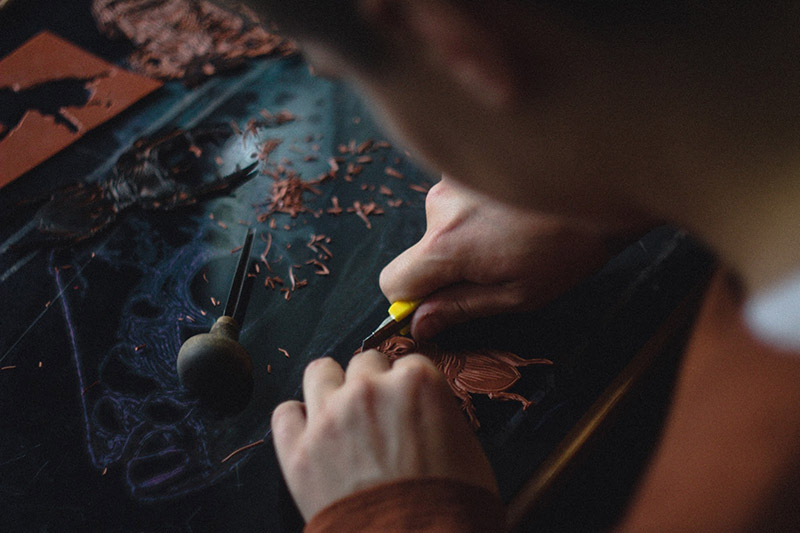
Leather tanning: vegetable or chrome ?
During the production of leather, tanning is a mandatory and essential step. No, it doesn’t mean it was left out in the sun to pick up some color ! In fact, tanning is the process that turns animal skin into leather. The way this process is carried out has a significant impact on the quality of the leather, and this, for years to come.
The process of leather tanning
First, let’s talk about the tanning of the leather itself, which basically consists of transforming animal skins into leather. The transformation of an animal skin into a piece of leather is mainly made by removing water molecules from the collagen of the skin.
However, by removing the water, the skin can become damaged, as it becomes dry and inflexible. This is why for centuries people have soaked hides in natural tannins to dehydrate the leather.
This process replaces water molecules and binds to collagen, preventing the part where the leather becomes stiff and inflexible. These vegetable tannin solutions consist of organic substances present in trees.
This step consists of soaking the skins several times in natural tanning solutions, is slow and complex. It usually takes at least one to two months to be completed. This requires the supervision of skilled craftsmen.
A new method was then devised in 1858. It allows leather to be tanned very faster and cheaper by using a mixture of chemicals, mainly chromium. This method of chemical tanning has since then been the favorite method for tanning leather, which accounts for most of the leather in the world.
Vegetable leather tanning
Vegetable tanned leather uses natural tannins found in the bark of various species of trees to bind to collagen fibers in the skin. This prevents the leather from rotting and allows its preservation.Favorite material of craftsmen, vegetable tanned leather is most often chosen for its smell, its patina and the ease of its cutting. Indeed, far from being a leather for novice craftsmen, vegetable tanned leather is practically a religion in the world of leather craftsmanship. A choice of connoisseurs, one might say. For many, it’s vegetable tanning or nothing !
A true darling of craftsmanship, vegetable tanned leather is most often chosen for its smell, its patina, its way of cutting, patinating and sewing. Plus the way he ages and softens over time gives the impression that it molds to the user.
Far from being a beginner’s leather, vegetable tanned leather is practically a religion in the world of artisanal leather work. A choice of connoisseurs, one might say.
For many, it’s vegetable tanning or nothing ! Vegetable tanned leather is virtually impossible to copy using materials synthetics. The richness and depth of color cannot be imitated by plastic materials, and the impostor is immediately noticeable, even by an eye not warned.
On the other hand, the increased stiffness associated with most vegetable tanned leathers means that it is rarely necessary to use reinforcement liners. This means that the leather will retain its original shape and will not sag under its own weight.
Finally, the main characteristic of vegetable tanning is its eco-responsible quality. Using only products from the biosphere, vegetable tanning is a method considered more environmentally friendly.
Chrome leather tanning
Unlike vegetable tanning, chrome tanners do not get hides raw. The skins are subjected to an initial tanning process which gives a tint distinct bluish.
The basic principles of tanning are the same : water molecules are removed from the skin collagen, but using chromium salts instead of tannins. The ions of chromium which displace water are smaller than vegetable tanned molecules. This makes usually chrome tanned leather thinner and softer than vegetable tanned leather.
The process is usually carried out by placing the skins in drums or acid baths, composed of a mixture of chemicals. It creates loads of toxic wastewater which, if left untreated, can have a massive impact on the environment. As in India, where agricultural land is flooded with sewage from color blue. Poisoned by a concoction of chemicals such as lead, arsenic, chromium, methylisothiazolinone, anthracene and formaldehyde, they can cause serious health problems.
This technique is however the most widely used in the world today. Mainly because vegetable tanning has some disadvantages :
- It is initially a little stiff and needs to be broken in to become fully flexible and functional ;
- The colors of vegetable tanning are not as vivid as those of vegetable tanning chrome and darken over time ;
- Vegetable tanning takes a long time, which makes the products generally more expensive.
The alternative to chrome is therefore justified by many advantages such as resistance to water and heat. Because of these characteristics, chrome-tanned leathers are often used to make shoes, boots or gloves.
Additionally, chrome tanned leather generally requires less maintenance. It is rarely necessary to condition it. Unless it is an item that gets wet on a regular basis and dried out, or that flex excessively on a regular basis (e.g. shoes).
Chrome-tanned hides and skins are also more supple from the day of purchase, while vegetable tanned leather generally softens with age and use. Some vegetable tanned leathers can be incredibly soft, but they won’t be as resistant than chrome ones.
Finally, the vibrant color options can be another reason to opt for the chrome tanned hides. If you like bright colors without color variation, in particular on fashion items and accessories, then chrome tanned leather can be your best choice.
The final choice ultimately depends on the tastes and colors of each. It is true that the chrome tanning has many advantages, but still less authentic than the vegetable one. Additionally, chromium is a chemical that is genuinely harmful to the environment and health. It’s definitely an argument to consider. Our planet deserves that we all make choices more and more aware.
Yasmine Besbes



